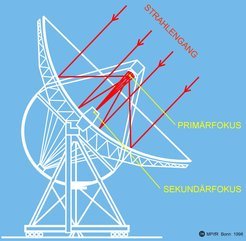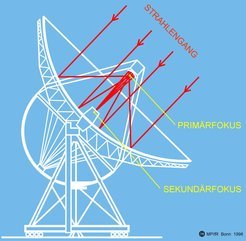Radio Astronomy as a way to explore the universe
Since the earliest of times, space has inspired our imagination. Cinema and television deeply influence the picture that we have of what goes beyond our daily lives on Earth. Many of us are familiar with terms like galaxies, extragalactic systems, comets, and asteroids.

The 100-metre radio telescope
The 100-metre radio telescope in Effelsberg is used by members of the Institute, as well as a large number of guest scientists from all over the world. The aerial photograph on the left shows the radio telescope with its mirror surface (the outer part of which was renewed in 1998). The control centre on the mountainside can be seen on the lower left. It hosts the control room, the measuring and computing rooms, electronic laboratories and workshops as well as to guest rooms for the scientists on site.
How does the parabolic reflector work?

The telescope consists of a parabolic main mirror with a diameter of 100 meters and a secondary mirror with a 6.5 metre diameter. The parabolic reflector concentrates radiation from space on a common focal point, the so-called primary focus. The focal point is located 30 metres above the mirror's surface. A secondary mirror near the focal point diverts the radiation towards a second focal point- the secondary focus- in the middle of the primary mirror. Both focal points are home to measuring cabins with low-noise detecting systems, and they can be used interchangeably.
The receivers used at the primary focus point detect frequencies between 800 MHz and 86 GHz. Switching between different receivers is done manually until the upgrade to be made in 2006. A focal length of 385 metres at the secondary focus point makes it possible for several receivers between 2.7 and 43 GHz to be used at the same time, and these receivers are ready for operation at any time. Even at larger distances from the optical axis geometrical errors are kept relatively small.

